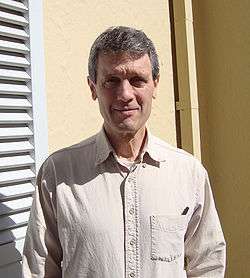Roger Evans Howe
| Roger Evans Howe | |
|---|---|
 Roger Howe in 2010 | |
| Born | May 23, 1945 |
| Nationality | US |
| Alma mater | |
| Known for | Representation theory |
| Awards | |
| Scientific career | |
| Fields | Mathematics |
| Institutions | |
| Thesis | On representations of nilpotent groups (1969) |
| Doctoral advisor | Calvin C. Moore |
| Doctoral students | |
| Website |
directory |
Roger Evans Howe (born May 23, 1945) is William R. Kenan, Jr. Professor Emeritus of Mathematics at Yale University, and Curtis D. Robert Endowed Chair in Mathematics Education at Texas A&M University. He is well known for his contributions to representation theory, and in particular for the notion of a reductive dual pair, sometimes known as a Howe pair, and the Howe correspondence. His contributions to mathematics education is also well-documented. [1]
Biography
He attended Ithaca High School, then Harvard University as an undergraduate, winning the William Lowell Putnam Mathematical Competition in 1964. He obtained his Ph.D. from University of California, Berkeley in 1969. His thesis, titled On representations of nilpotent groups, was written under the supervision of Calvin Moore. Between 1969 and 1974, Howe taught at the State University of New York in Stony Brook before joining the Yale faculty in 1974. His doctoral students include Ju-Lee Kim, Jian-Shu Li, Zeev Rudnick, Eng-Chye Tan, and Chen-Bo Zhu. He moved to Texas A&M University in 2015.[2]
He has been a member of the American Academy of Arts and Sciences since 1993, and a member of the National Academy of Sciences since 1994.
Howe received a Lester R. Ford Award in 1984.[3] In 2006 he was awarded the American Mathematical Society Distinguished Public Service Award in recognition of his "multifaceted contributions to mathematics and to mathematics education."[4] In 2012 he became a fellow of the American Mathematical Society.[5]
Selected works
- Roger Howe, "Tamely ramified supercuspidal representations of Gln", Pacific Journal of Mathematics 73 (1977), no. 2, 437–460.
- Roger Howe and Calvin C. Moore, "Asymptotic properties of unitary representations", Journal of Functional Analysis 32 (1979), no. 1, 72–96.
- Howe, Roger (1979), "θ-series and invariant theory", in Automorphic forms, representations and L-functions (Proc. Sympos. Pure Math., XXXIII, American Mathematical Society), pp. 275–285.
- Howe, Roger (1989), "Remarks on classical invariant theory", Transactions of the American Mathematical Society, 313 (2): 539–570, doi:10.2307/2001418, ISSN 0002-9947, JSTOR 2001418, MR 0986027
- Howe, Roger (1989), "Transcending classical invariant theory", Journal of the American Mathematical Society, 2 (3): 535–552, doi:10.1090/S0894-0347-1989-0985172-6
- Howe, Roger; Umeda, Toru (1991), "The Capelli identity, the double commutant theorem, and multiplicity-free actions", Mathematische Annalen, 290 (1): 565–619, doi:10.1007/BF01459261
- Roger Howe & Eng-Chye Tan, "Nonabelian harmonic analysis. Applications of SL(2,R)". Universitext. Springer-Verlag, New York, 1992. xvi+257 pp. ISBN 0-387-97768-6.
- Roger Howe & William Barker (2007) Continuous Symmetry: From Euclid to Klein, American Mathematical Society,
ISBN 978-0-8218-3900-3 .
- Robin Hartshorne (2011) Review of Continuous Symmetry, American Mathematical Monthly 118:565–8.
See also
References
- ↑ Li, Yeping; Lewis, W. James; Madden, James (Eds.) (2018). Mathematics Matters in Education. Essays in Honor of Roger E. Howe. Springer. ISBN 9783319614342.
- ↑ "World-renowned Mathematician and Mathematics Educator Joins Faculty". Texas A&M Today. June 5, 2015.
- ↑ Howe, Roger (1983). "Very basic Lie theory". Amer. Math. Monthly. 90: 600–623. doi:10.2307/2323277.
- ↑ Roger Howe Receives 2006 AMS Award for Distinguished Public Service
- ↑ List of Fellows of the American Mathematical Society, retrieved 2013-01-21.
External links